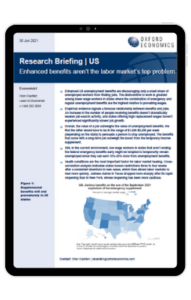US | Enhanced benefits aren’t the labor market’s top problem

Enhanced US unemployment benefits are discouraging only a small share of unemployed workers from finding jobs. The disincentive to work is greatest among lower-wage workers in states where the combination of emergency and regular unemployment benefits are the highest relative to prevailing wages.
What you will learn:
- An increase in the number of people receiving benefits doesn’t dramatically weaken job-search activity, and states offering high replacement wages haven’t experienced significantly slower job growth.
- In the current environment, low-wage workers in states that aren’t ending the federal emergency benefits early might be tempted to temporarily remain unemployed since they can earn 10%-20% more from unemployment benefits.
- Health conditions are the most important factor for labor market healing. Cross-correlation analysis indicates states loosen restrictions three to four weeks after a consistent downturn in new cases, which then allows labor markets to heal more quickly.
Tags:
Related Services

Post
Eurozone: Little sign of harm from the Red Sea disruptions
The impact of Red Sea shipping disruption on the eurozone economy continues to be limited, in line with our baseline view. Our new Eurozone Supply Stress Indicator suggests that supply pressures have returned to normal following a period of easing in 2023.
Find Out More
Post
GCC: Key themes shaping city economies in the near term
For Gulf cities, the near-term outlook will be tied not only to the global macroeconomic backdrop, but also the progress of the diverse visions and strategies in the region. With the aim to diversify their economies and reduce the dependence on oil, Gulf states continue to invest in the non-oil economy and implement various reforms. That said, oil revenues remain key to funding diversification efforts.
Find Out More